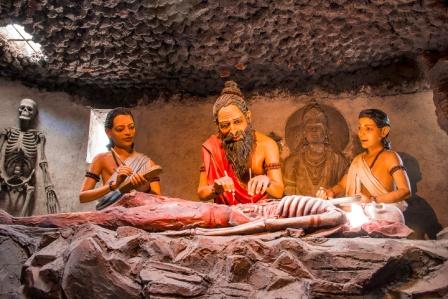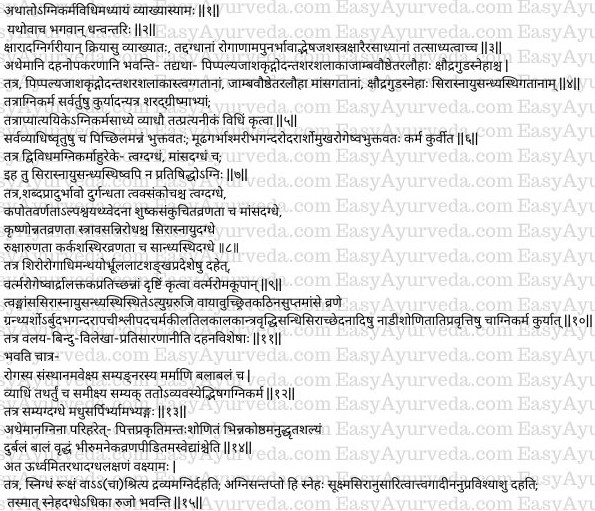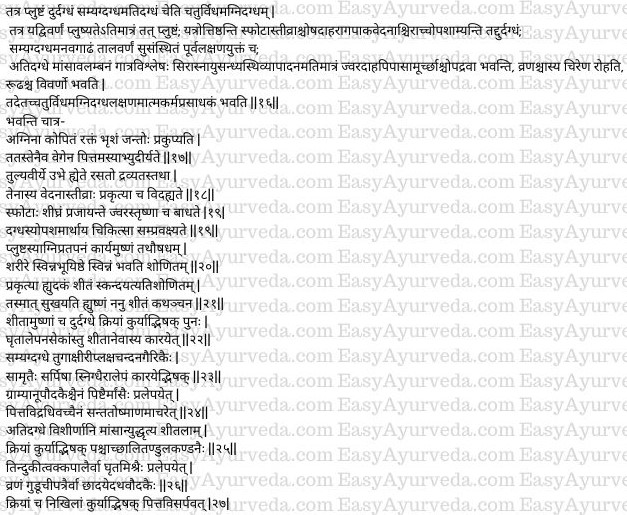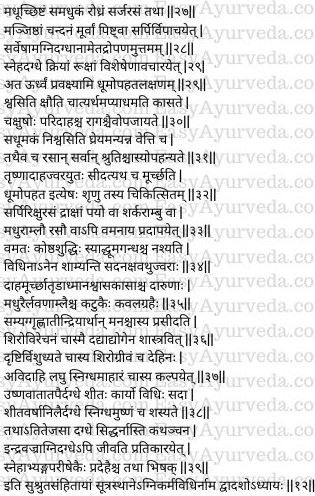This article explains Sushruta Samhita Sutrasthana Chapter 12 “Agnikarma Vidhi Adhyaya”- Procedure of branding by fire (thermal cautery).


Agnikarma Vidhi
Procedure of branding by fire (thermal cautery)
We will now expound the chapter by name Agnikarma vidhi – procedure of branding by fire (thermal cautery); as revealed by the venerable Dhanvantari.
Agni Karma Shrestha
Greatness of fire cautery
It is said that Agni (fire) is better than Kshara (alkali) in action (of burning). This is because the diseases treated (and cured) by burning (by fire) will not recur again. Also, the diseases which are incurable by use of bhesaja (medicines), shastra (sharp instruments) and kshara (alkali) will be effectively cured by use of fire (thermal cauterization).
Read – Kshara Agnikarma Vidhi – Cauterization- Astanga Hridaya Sutrasthana 30
Dahana Upakaranani
Equipments required for burning by fire (fire cautery)
- Pippali – long pepper
- Excreta of goat
- Tooth of cows
- Shara – arrow head
- Shalaka – metal rod
- Jambavoustha – piece of black stone made like jambu phala i.e., fruit of Syzygium cumini Linn
- Itara lauha – rods of other metals
- Honey
- Jaggery
- Sneha – fats (oil, ghee, muscle fat, bone marrow)
Read – Snehana – Oils and Fats Treatment – Ashtanga Hrudayam Sutrasthana 16
Areas of utility
Among these,
| Sl No | Material used for Agnikarma | Area of utility |
| 1 | Long pepper, goat’s excreta, cow’s teeth, arrow head and metal rod | Branding the diseases of the skin |
| 2 | Jambavoushta and rods of other metals | Branding in diseases of the muscles |
| 3 | Honey, jaggery and fats | Branding in diseases present in the veins, ligaments, bony joints and bones |
Agni Karma Kala
Suitable time for conducting fire cautery
Branding by fire can be done in all seasons except Sarat (autumn) and grishma (summer). In the event of emergency, agnikarma can be done in these seasons also (autumn and summer), in diseases which are curable only by means of fire branding. The physician / surgeon shall adopt counter methods before doing the branding.
Notes: Dalhana mentions covering the body or the site of branding with moist cloth, use of cold foods and applying pastes which are cooling etc. as counter methods to mitigate the effect of burning.
Read – Burning Sensation – Ayurvedic Understanding And Treatment
Agnikarma vidhi
Procedure for branding
In all diseases and seasons, branding should be done after the patient has consumed food which is slimy (cold in potency and soft). On the contrary, fire cautery should be done on an empty stomach (when the patient has not taken any food) in diseases such as obstructed fetus, urinary calculus, fistula-in-ano, enlargement of the abdomen, piles (hemorrhoids) and diseases of the mouth.
Bheda
Kinds of branding
According to some authorities branding (with fire) is of two kinds viz,
- Tvak Dagdha – burning of the skin and
- Mamsa Dagha – burning of the muscles
But here (in our opinion – according to the Dhanwantari school of thought) branding of veins, ligaments, bony joints and bones also is not prohibited (branding of these structures can also be done).
Read – Ayurvedic Treatment For Non Bleeding Piles: Shushka Arsha Chikitsa
Signs and Symptoms
Signs of burning of skin, muscles, veins, tendons, joints and bones
Tvak Dagdha Lakshana – production of sound, bad odor and constriction of the skin- are the signs of tvak dagdha i.e., burning of the skin.
Mamsa Dagdha Lakshana – appearance of color like that of the pigeon i.e., ash color or dark grey color, mild swelling, pain and dryness and constriction of the wound (ulcer) – are the signs of mamsa dagdha i.e., burning of the muscle.
Sira Snayu Dagdha Lakshana – ulcer becoming black and elevated and cessation of exudation – are the signs of sira snayu dagdha (burning of veins and tendons).
Sandhi-Asthi Dagdha Lakshana – appearance of dryness and slight red color, roughness and firmness (hardness) of the ulcer – are the signs of sandhi- asthi dagdha (burning of joints and bone).
Dahana pradesha
Sites of Branding
In diseases of the head and Adhimantha (a disease of the eye – glaucoma) branding should be done on the eyebrows, forehead and / or the temples.
In diseases of the eyelids, branding should be done on the follicles of hairs (eye lashes) after covering the area of vision (pupil and cornea) with a pad of wet cloth.
Burning (branding) should also be done in conditions such as –
- presence of very severe pain in the skin, muscles, veins, ligaments, joints and bones caused by aggravated vata
- muscular outgrowths which become hard and numb (loss of sensation) in the ulcer (wound)
- cysts / tumors
- hemorrhoids
- malignant tumor
- fistula-in-ano
- glandular swelling in the neck
- filariasis
- warts on the skin
- moles
- hernia
- tearing pain in the joints
- tearing of veins
- sinus ulcers
- excessive bleeding (profuse hemorrhages)
Different patterns of branding
Different patterns (shapes) of branding (fire cautery) are –
- Valaya – circular, ring-like
- Bindu – dot
- Vilekha – straight line and
- Pratisarana – spread wide, flat
The physician should conduct branding (with fire) after carefully considering –
- the gravity of symptoms of the diseases,
- the vital spots,
- strength of the patient,
- disease and seasons
Once the branding (thermal cauterization) has been done in a proper way, the burnt area should be anointed with a mixture of honey and ghee.
Read – How To Use Ghee For Skin Care? A Simple Ayurveda Method
Agni Karma anarha
Contraindication of branding
Branding by fire (thermal cautery) should be avoided in the below mentioned kinds of persons (and conditions) –
- persons of Pitta predominant constitution,
- having bleeding disorders (or in whom blood has been accumulated in the abdomen)
- diarrhea / rupture of abdominal organs
- in whom the foreign body has not been removed,
- those debilitated
- children
- aged persons
- those fearful
- those suffering from multiple wounds / ulcers,
- those unfit for sudation therapy (vide chap 32, chikitsa sthana)
Anyatha Dagdha
Burning other than banding
Further on, we will describe the features of other kinds of burning (for the treatments of diseases),
- agni (fire/ heat) burns the body residing in substances which are unctuous (fatty, oily) and dry;
- fatty substances getting heated by fire, being capable of travelling through the minutest veins and pores enters very quickly into the skin and other tissues and causes burning therein, therefore there will be severe pain when burnt by fatty substances
Dagdha bheda
Kinds of burns
Agnidagdha i.e., burns caused by fire are of four kinds, they are –
Plusta Dagdha (scorched burns) – is a condition in which the skin color gets extremely deformed i.e., severe discoloration occurs and appears to be burnt i.e., not totally burnt (but will have burning sensation).
Dur-Dagdha (blistered burns) – is that in which vesicles associated with severe sucking type of pain, burning sensation, redness, suppuration (exudation, ulceration) and pain appear and subside after a long time.
Samyak Dagdha (superficial burns) – is that which is not deep, has the color of tala phala, is even (without elevation or depression) and having the symptoms mentioned earlier (burning of skin, muscles, veins etc.).
Ati-Dagdha (deep burns) – is that in which the burnt muscles are seen hanging loose, the parts of the body or the joints get dislocated, excessive destruction (pain) of veins, ligaments, joints, bones and is associated with complications in the form of fever, burning sensation, and thirst and fainting. The wounds / ulcers (caused by burning) heal after a long time and even the healed ulcers become discolored.
The comprehensive knowledge of the features (symptoms) of these four kinds of agni dagdha (degrees of burns) will help the physician to perform and attain success while treating the patient.
Read – How To Make Herbal Oil To Remove Burn Scars
Aggravation of blood and pitta by the burns
The blood aggravated by fire undergoes further (greater) aggravation in the body of the person. Due to this aggravation and intensity of the blood, the pitta also gets aggravated in the same pace (speed). This is because both blood and pitta are similar in their potency, taste and substance. As a result of (aggravation of both blood and pitta) this, severe pain occurs and the burning sensation would naturally occur, blisters (vesicles) develop quickly and severe increase of fever and thirst.
Sanskrit Versus






Dagdha Chikista
Treatment of burns
Plushta Dagdha Treatment
Now we shall explain the treatment to mitigate the sufferings of a person who has been suffering from burns –
Plushta Dagdha (burns of the first degree) – In this condition, the burnt area should be given heat from the fire (warming the body, increasing the body temperature). Likewise, drugs / medicines of hot potency should be administered for external application and internal medicines (oral consumption). When the body starts sweating due to the effect of burns (due to the increase in body temperature due to burns), the blood too starts getting liquefied. In this condition if cold comforts are given or if cold water is used (to sprinkle etc), the water by the nature of its cold potency would thicken the blood i.e., cause coagulation of blood. Therefore, hot water alone (hot comforts) should be used for irrigating the ulcers / wounds (caused by burns) and also for drinking purposes. Cold water or cold things should never be used.
Read – Veerya, Potency Of Herbs And Doshas – Inter-relationship
Durdagdha Treatment
Durdagdha (burns of the second degree) – In this condition, the physician should resort to both warm and cold therapies / comforts. But ghee, anointments and bathing (showering) of the body should be done in cold state only (with herbs, ghee and liquids having cold potency or prepared cold).
Samyak Dagdha Treatment
Samyak Dagdha (burns of third degree) – In this condition, Tugaksiri, Plaksa, Candana, Gairika and Amrta should be ground on a clean stone slab (or in mortar) and made into smooth paste. This paste shall be mixed with ghee and applied over the body (alternatively the ghee prepared with these herbs shall be used for application). Also, the paste of the meat of domestic animals, those living in marshy regions and those living in water should be applied over the body. If there is constant burning sensation in the burnt area or the whole-body treatment should be done on the lines of treating ‘pitta vidradhi’ i.e., abscess of pitta origin.
Read – Vidradhi: Causes, Pathogenesis, Types, Treatment, Medicines
Atidagdha Treatment
Atidagdha (burn of the fourth degree) – In this condition, firstly the torn (and loosely hanging) muscle should be removed (by cutting) followed by cold therapies / comforts. Later the physician should apply the powder of broken rice or decoction of tinduki bark mixed with ghee. Or the wound / ulcer (caused by burns) should be covered with leaves of Guduchi or aquatic plants (like lotus etc). All other treatments should be done on the lines of treating ‘pittaja visarpa’ – herpes / erysipelas of pitta origin.
Maducchistadi Ghrta
Madhucchista, Madhuka, Rodhra, Sarjarasa, Manjista, Candana and Murva should be macerated together and made into paste. Ghee should be processed and prepared with this paste. This is the best one for healing burnt wounds of all kinds. In case of burns caused by hot fats (oil, ghee etc), dry treatments should be done especially.
Dhumopahata Lakshana
Suffocation by smoke
Now we will describe the symptoms of dhumopahata i.e., the person troubled by smoke (suffocation). The symptoms are as listed below –
- increased respiration / difficulty in breathing (dyspnoea)
- continued and repeated sneezing,
- distension of abdomen / flatulence and
- burning sensation in the eyes
- redness in the eyes
- exhales smoke or presence of smell of smoke in the breath
- perceives smell of only smoke and does not perceive the smell of anything else
- loss of perception of all tastes
- impairment of hearing capacity (loss of sound perception)
- thirst
- burning sensation
- fever
- debility / weakness
- fainting
Now listen to the treatment of this condition.
Treatment of Dhumopahata
Vamana (emesis) – At the beginning, emesis should be administered to the person suffering from dhumopahata. For inducing emesis, one should use any of the ghee, juice of sugarcane, draksa, milk, sugar water, things of sweet or sour tastes should be used. Emesis therapy shall cause koshta shuddhi i.e., cleansing of the alimentary tract and chest. The smell of the smoke too disappears. Apart from this (as an effect of emesis therapy) debility, sneezing and fever would get pacified. Also, burning sensation, fainting, thirst, distension / flatulence and severe dyspnoea and cough are also relieved.
Kavala (mouth gargles) – By doing mouth gargles with liquids and decoctions prepared with herbs having sweet, salt, sour and pungent tastes, the person will be able to perceive objects by all the senses. His mind also would become clear.
Shiro Virechana (nasal medication to cause purging of head) – After having administered emesis therapy, the physician who has comprehensive knowledge of therapies shall skillfully administer purging errhines, adhering to the procedures explained in Ayurveda. By this, his sight (vision) becomes clear, so also his head and neck.
Following this, the patient should be given foods which are light (easily digestible) and unctuous and do not cause burning sensation.
Read – External Treatments To Keep Doshas In Balance
Atapadi Dagdha
Sunstroke etc: –
In burns caused by hot breeze and severe sun-heat / sunlight (sunstroke) all cold treatments should be done always.
For those afflicted by severe cold, rain storm and cold breeze, treatments / comforts which are unctuous and hot will be ideal (beneficial).
In case of assault by severe lightning or thunder any type of treatment will not yield success. If by chance or luck, if any person has survived these assaults and is found alive, the physician shall treat him with unctuous therapies, oil massage, oil bath (showering) and application of warm and thick paste of herbs.
Thus ends the Twelfth chapter by name Agnikarma Vidhi- in Sutra Sthana of Susruta Samhita.















